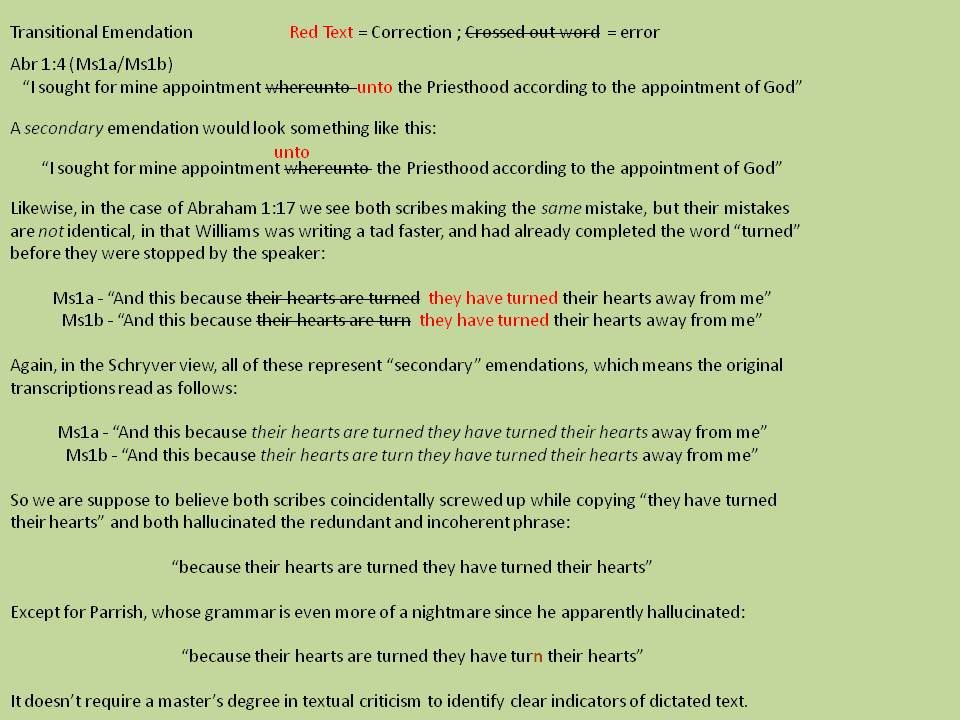Although I suspect this will be dismissed as yet another "vague meta-methodological" objection, I will inject this point anyway. Maklelan, if I am reading him correctly, proposes a scenario in which Joseph Smith read one manuscript to two scribes to facilitate the speedy manufacture of two copies. Then, in the case of the
homoioteleuton, the reader accidentally re-read a portion of his manuscript (and got fairly far before he realized it), or was given the manuscript to look at and accidentally recopied a passage in error.
Since it is my belief that historical or "external" evidences do matter in understanding the text, I think it is important to poke at the underlying assumptions about the proposed dictation or transcription. Therefore, I pose the following questions, with my preliminary answers that await refutation by those more experienced in these areas:
1) Joseph Smith seemed to be deeply concerned about inaccuracies in the scriptures. To quote him:
TPJS wrote:I believe the Bible as it read when it came from the pen of the original writers. Ignorant translators, careless transcribers, or designing and corrupt priests have committed many errors
Given his concern, is it more or less likely that he would rely on a method of transmission that was bound to introduce errors into the text? What was the purpose of producing three manuscripts that were more likely to disagree with each other because of the unreliability of the method?
2) Is there any reason to suppose that circumstances required relying on such an unreliable method? Mak says that the reason is for speed, but why was speed necessary? Is there a historical explanation for this? After spending months working with these documents and the pure language, why haste at this point?
3) Again, the scribal tradition surrounding the biblical text (and here, again, I am not an expert) seems to me to have been one of copying from an exemplar as accurately as possible, with the errors introduced coming from misreading, skipping of the eye, nodding off, etc. Given that tradition, and Joseph Smith's apparent awareness of it, why would Joseph have taken so little care in providing for greater accuracy in the transmission of the supposed Ur manuscript of the Book of Abraham, chapters 1-2.x?
Unless there is a compelling reason to suppose that, instead of copying the Ur manuscript on sight, exigencies forced Joseph to make haste and forgo his usual concern with the accuracy of sacred text, then I think that maklelan's theory is problematic. Indeed, I should think that one must either account for the evidences for dictation as Will is attempting to do, thus showing that there is visual copying going on, or one must account for the dittography and then accept the evidence for dictation.
I would want to see some evidence that, contrary to his stated philosophy concerning the accuracy of the scriptures, instances of him transmitting a translation of ancient writings through reading from the Ur manuscript to the scribes. Then I would be more willing to entertain that theory. Otherwise, it looks like that magic bullet to me.
Finally, concerning orthography. I have never doubted that orthography in the 19th century was not standardized. In spite of that Joseph Smith thought it was important to spell out the names of figures in the Book of Mormon. And, again, although a scribe may follow his own lights in putting what he hears to writing, he is less likely to deviate from the manuscript he is copying. Or am I wrong? Anyway, I think this is problematic for Will, but obviously not for maklelan and his dictation from a written manuscript model.
“I was hooked from the start,” Snoop Dogg said. “We talked about the purpose of life, played Mousetrap, and ate brownies. The kids thought it was off the hook, for real.”

